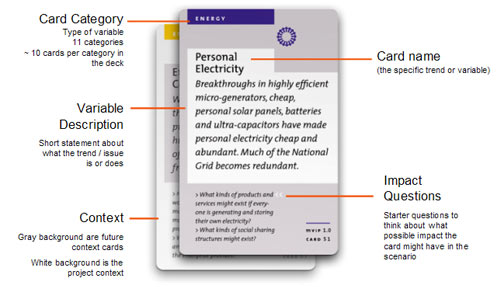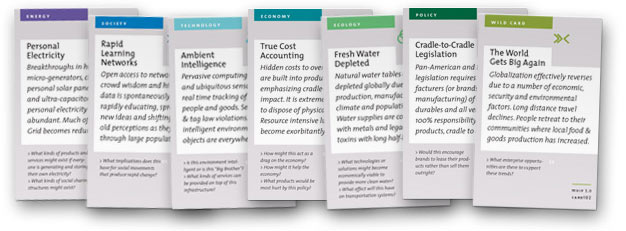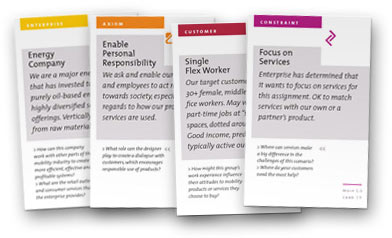![]()
![]()
![]()
![]()
Workshop guides are available as a downloadable and printable handout in pdf form (click to download):
Standard play (48K)
Types of play (36K)
mVIP concept
As designers & creators of products or services in the mobility sector, we are generally working for an enterprise either on a payroll or as a consultant. The mobility vision integration process or mvip cards can help you and your team, exercise your abilities to account for and adapt to diverse factors that you have no control over, but which will influence your creative decision making processes.
When we design and innovate we merge our personal values with the needs and values of the enterprise, our community, and the customer we serve.
The mVIP cards simulate this set of conditions by reflecting the conditions of the world and the project conditions under which innovation needs to occur.

Card categories
There are 109 cards in the current deck across 11 categories. The authors strived to create a deck that challenges the player with some dramatic but plausible possibilities for the year 2040. The deck is also balanced with both positive and negative trends and events.
The mVIP deck is configured to allow multiple individuals or teams to simultaneously play at the same time. There are two types of cards. One type deals with the design context and consists of four categories: enterprise, axiom, customer, and constraint The other type deals with ambient trends & issues that together describe the future within which the design context is placed. There are seven categories of trends: energy, economy, society, ecology, technology, policy, and wildcard.
Each card identifies the card category and the specific variable description as shown below.
.

Ambient trends & issues (future context)
What do you need to know about the world around you? There are social considerations, technological advances, economic realities, ecological concerns & political trends that can all affect the success of your project. Although these might not appear relevant to a transportation system or mobility solution, each and every one of these issues can seriously affect the success of your solution. Because the focus of these cards is mobility, we cannot dismiss the uncertainties we face regarding our future energy sources either. Additionally, how do you also cope with a totally unexpected event, catastrophe or windfall–the wildcard of life?

Design context
When we design and innovate we merge our personal values with the needs and values of the enterprise, our community, and the customer we serve. The cards simulate this set of conditions. The enterprise will be of a particular kind: manufacturer, service provider, logistical support, retail outlet, etc. The enterprise will have an axiom – that is, it will have a particular vision of how it wishes to be perceived as a company or of what its trading philosophy is. The assignment that you as a designer will work on will probably have a particular customer class in mind. There will most likely be a constraint placed on the assignment, such as cost, low carbon footprint or outstanding energy efficiency, for instance. These four factors, will all be known by you as you start the project.

Workshop guide and tips
Standard play
Appropriate for introduction to the cards and for general scenario work.
Divide group (or table) into teams of 4-5 people.
1) Trends & issues
To start, each player/group will get the seven “future context” cards (gray background)
Allow time to discuss this Future Context. ~15 minutes
Take a few minutes to consider how these pieces fit together. Read between the lines. What holds this story together? How might one variable have caused another? Imagine what everyday people experience by living in this world.
2) Design Context
After orienting yourself to the future context four Design Context cards are added to your hand.
These four cards will describe your job and additional project constraints for this scenario.
Enterprise: The company you work for in the scenario.
Axiom: The company’s philosophy, brand promise, current mission
Customer: The target customer group your are trying to satisfy
Constraint: An additional constraint because ...interesting projects always have them.
Allow time to brainstorm about how the enterprise can satisfy the customer in within this future. ~ 40 minutes
3) To complete a scenario answer this:
What is the mobility design solution and business model that is optimized to sustain the customer, your business and the world within this future?
Have each group give a short report back ~ 5 minutes
Types of Play
There are two types of play documented; Standard play and Texas Hold'em. For each of these styles refer to the Workshop Guide and Tips (see pdf's above) for details and suggestions on the individual steps. Just like a playing card deck there are many ways to "play" the mVIP cards. New ways are being invented continuously. If you have success with any methods we'd like to hear about it
![]()
![]()